Emerald ash borer (factsheet)
We have archived this page and will not be updating it.
You can use it for research or reference.
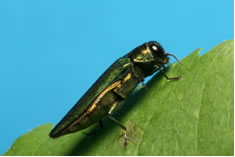
Adult emerald ash borer (7.5–15 mm long).
French common name: Agrile du frêne
Scientific name: Agrilus planipennis Fairmaire
Order: Coleoptera
Family: Buprestidae
Distribution
The emerald ash borer is an Asian species native to China, Japan, Taiwan, Korea, Mongolia and the Russian Far East. In 2002, the beetle was detected for the first time in North America in the vicinity of Detroit, Michigan, and later in Windsor, Ontario. Data from tree ring analysis indicated that the beetle had probably been present in those areas since the early 1990s.
In Canada, emerald ash borer has been detected throughout southwestern Ontario, in Ottawa and nearby counties in eastern Ontario, and in Sault Ste. Marie and on Manitoulin Island in northern Ontario. In Quebec, the beetle has been found in the vicinity of Carignan and nearby municipalities, in Gatineau, on Montreal Island and in Ville de Laval. The pest has also been confirmed in 21 states in the United States.
The areas in Canada currently regulated for emerald ash borer can be found on the Canadian Food Inspection Agency’s website. A map showing the current North American distribution of the emerald ash borer is available from the Cooperative Emerald Ash Borer Project.
Hosts in Canada
Principal hosts in Canada
Green ash, white ash, black ash, pumpkin ash and blue ash
Other hosts
Other native and exotic species of ash (Fraxinus spp.)
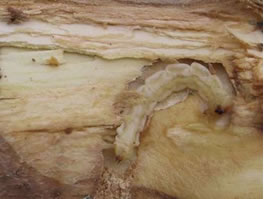
Mature emerald ash borer larva (26–32 mm long).
In northeastern North America, five species of native ash have been attacked by emerald ash borer. All five of these species occur in Canada and all but blue ash are highly susceptible. Although attacked, blue ash, an uncommon species occurring in southwestern Ontario, seems to be somewhat resistant.
Ashes are an important component in many forest communities in Canada from Saskatchewan eastward. There are an additional 15 species of ash in North America, but most of these species are confined to the southwestern United States and Mexico. One species, Oregon ash, may or may not be native to British Columbia. Ash trees have been extensively planted in municipalities throughout Canada and in shelterbelts in the Prairie provinces, often outside of their native range, and all are at risk.
Life history
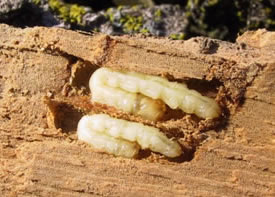
Prepupae of emerald ash borer. This is the stage in which most of the population overwinters in southern Ontario.
In Canada, beginning in late May and early June adults of the emerald ash borer emerge by chewing out through the bark of the host tree, creating a characteristic D-shaped hole. The adults feed on the host foliage for a period of up to two weeks prior to mating and egg laying. Males locate females for mating by a combination of pheromonal and visual cues. Females lay their eggs in bark crevices or under bark scales on the branches and trunks of the host trees. Larvae hatch from the tiny (0.6 by 1.0 mm) disk-shaped eggs after one to two weeks of incubation, depending on the temperature. The newly hatched larva tunnels out the bottom of the egg, down through the layers of the bark until it reaches the interface between the bark and the wood. There it feeds and excavates an S-shaped tunnel, where it grows and develops through four moults of its exoskeleton. The larva then chews a tunnel into either the wood or the bark, forming a chamber in which it will pupate. The larva doubles over on itself in the chamber and becomes a J-shaped prepupa. This is the stage in which most of the population overwinters in southern Ontario. A small number (~20%) of larvae in southern Ontario, and a greater number in more northerly climates, don’t reach maturity and require a second winter to complete development. In spring, prepupae transform into pupae in these chambers and eventually into adults.
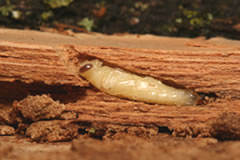
Emerald ash borer pupa, which will become an adult.
Ecology
On average, prepupae of the emerald ash borer are able to withstand minimum temperatures of about –30°C, in part through the production of antifreeze compounds. Under-bark temperatures where the prepupae overwinter are often higher than air temperatures. These two factors suggest that the beetle may be able to survive in most areas where ash occurs naturally or has been planted. In more northerly climates, the preponderance of a two-year life cycle will slow population increase and natural spread.
Initial surveys in Michigan indicated that few (<1%) native parasitoids from related species had made the shift to emerald ash borer. However, recent surveys in Canada suggest that some native parasitoids are having an impact on emerald ash borer populations and may potentially be exploited as biocontrol agents. Woodpeckers are the only native predators that feed extensively on the borer. Three parasitoids from China that are highly specific and cause substantial mortality to emerald ash borer in Asia have been imported, cultured and released in the United States. One of these species has been released recently at a single site in Ontario. Some native fungal pathogens (insect diseases) have also been recovered from emerald ash borer and these are also being tested as biocontrol agents.
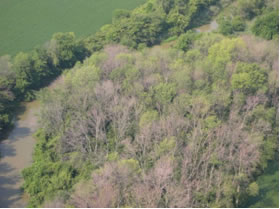
Ash stand severely damaged by emerald ash borer.
Attack and damage
Adults feed on the edges of the foliage, but it is the feeding of the larvae between the bark and sapwood which results in ash tree mortality. The tree’s transportation system, which moves nutrients throughout the tree and brings water up from the roots, is destroyed by the feeding of the larvae, resulting in the death of the tree by girdling.
Signs and symptoms of attack include crown dieback, bark deformities, woodpecker feeding holes, D-shaped emergence holes and shoots growing out of the trunk, roots and branches of the trees. Signs and symptoms of attack are not obvious until populations of the beetle are well established.
Status in Canada
The emerald ash borer is characterized as an invasive species that was accidentally imported into North America, probably via wooden packaging materials, and is causing both economic and ecological impacts. The distribution of emerald ash borer in Canada will continue to increase from the natural spread of the insect through flight and by the human-assisted movement of infested ash commodities (firewood, nursery stock and wood products).
Impacts
Ash is an important component of stream-side habitats, and the loss of these trees will result in erosion of soils into streams and changes in water temperature with increased solar exposure. Gaps in the canopy of wooded areas, caused by ash tree mortality, will affect the microclimate of the forest required by some species and facilitate the invasion of exotic plant species. Ash loss will also result in reduced biodiversity of herbivores that depend on ash for food. Ash trees in the urban environment also provide economic and ecological services, such as increased property values, windbreaks, temperature mitigation, pollution abatement, runoff prevention and provision of habitat for wildlife. An economic analysis of the impact in Canadian municipalities, based solely on insecticide treatments, tree removals and tree replacements, was published by McKenney et al. in 2012.
Links
References
References
Lyons, D.B., C. Caister, P. de Groot, B. Hamilton, K. Marchant, T. Scarr, and J. Turgeon. 2007. Survey guide for detection of emerald ash borer. Sault Ste. Marie and Ottawa, ON: Canadian Forest Service, Natural Resources Canada and Canadian Food Inspection Agency.
Lyons, D.B., R. Lavallee, G. Kyei-Poku, K. van Frankenhuyzen, S. Johny, C. Guertin, J.A. Francese, G.C. Jones, and M. Blais. 2012. Towards the development of an autocontamination trap system to manage populations of emerald ash borer (Coleoptera: Buprestidae) with the native entompathogenic fungus, Beauveria bassiana. Journal of Economic Entomology 105: 1929–1939.
McKenney, D.W., J.H. Pedlar, D. Yemshanov, D.B. Lyons, K.L. Campbell, and K. Lawrence. 2012. Estimates of the potential cost of emerald ash borer (Agrilus planipennis Fairmaire) in Canadian municipalities. Arboriculture & Urban Forestry 38: 81–91.
Ryall, K.L., P.J. Silk, P. Mayo, D. Crook, A. Khrimian, A.A. Cosse, J. Sweeney, and T. Scarr. 2012. Attraction of Agrilus planipennis (Coleoptera: Buprestidae) to a volatile pheromone: effects of release rate, host volatile, and trap placement. Environmental Entomology 41: 648–656.
Page details
- Date modified: